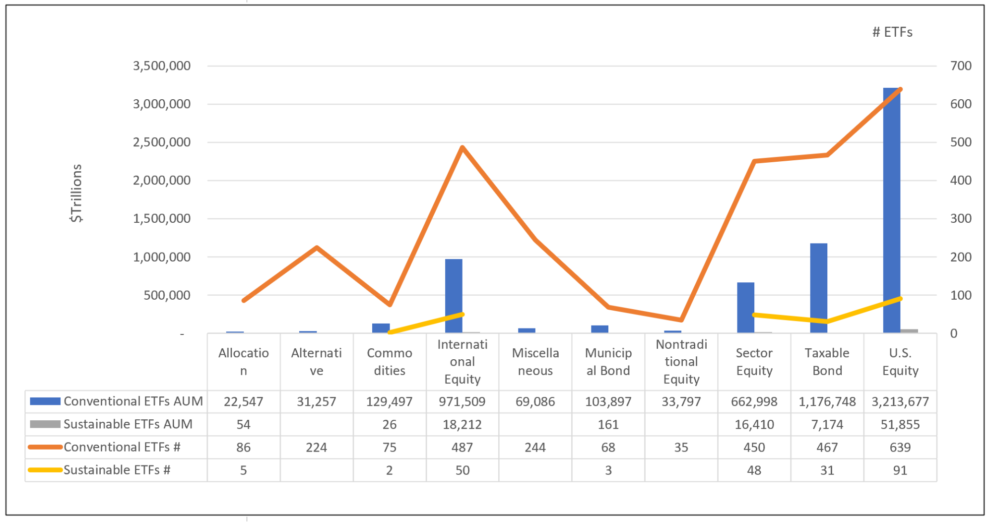The Bottom Line: On the 30th anniversary of ETFs, sustainable ETFs make up 1.4% of net assets but have the potential for continued rapid growth.
0:00
/
0:00
Listen to this article now
Conventional ETFs versus sustainable ETFs: AUM and number of funds as of 12/31/2022 Sources: Sources: AUM and number of funds: Morningstar Direct; sustainable investing strategies source=Sustainable Research and Analysis LLC.
Sources: Sources: AUM and number of funds: Morningstar Direct; sustainable investing strategies source=Sustainable Research and Analysis LLC.
Observations:
- Last week marked the 30th anniversary of the very first ETF to be listed on a U.S. stock exchange. The SPDR S&P 500 ETF Trust (SPY) was launched on January 23, 1993, reportedly with an initial seeding of $11.5 million put up by Spear Leeds. The fund has since become the largest ETF in the world with $356.7 billion in net assets as of December 31, 2022. This fund alone accounts for 5% of the ETF industry’s assets.
- Today, there are 3,148 ETFs listed in the US with $6.5 trillion in net assets, and over $9 trillion worldwide. Originally limited to equity index funds, the ETF industry has exploded over the last 30 years, in terms of number of funds, asset classes, investment strategies, and assets under management. The expansion has included the introduction of actively managed funds as well as sustainable ETFs. Actively managed ETFs have pulled in $349.6 billion in assets under management and account for 5.4% of assets. A smaller but growing segment consists of sustainable ETFs that, at $93.9 billion, makes up 1.4% of net assets spread across 230 ETFs.
- The largest but not the first sustainable ETF is the $19.6 billion iShares ESG Aware MSCI USA ETF (ESGU). The first listed sustainable ETF still in operation ranked 17th by size at $3.6 billion and is now named the iShares MSCI KLD 400 Social ETF (DSI). The fund was originally listed by Barclays Global Investors on January 24, 2005 as the iShares KLD Select Social Index Fund. At that time, it tracked the KLD 400 Social Index (originally launched as the Domini 400 Social Index) which was designed to provide exposure to the common stocks of 400 companies drawn from the S&P 500 and Russell 3000 that were determined to have positive environmental, social and governance characteristics while excluding businesses beyond specified revenue thresholds involved in alcohol, tobacco, firearms, nuclear power, military weapons and gambling. The index has been modified several times since 2005, with the most significant change occurring following the MSCI acquisition of the RiskMetrics Group in 2010. The index constituents were thereafter selected from the MSCI USA Index based on MSCI ESG ratings that are defined by risk exposures rather than positive ESG performance attributes.
- As noted, sustainable ETFs still make up a small number of total ETFs in the US. That said, they have grown rapidly, expanding from around $23 billion at the start of 2020 to almost $94 billion, or a threefold increase.
- The overall profile of the sustainable ETFs segment contrasts with conventional ETFs in a few important ways, including a lower allocation to taxable bond funds and higher allocations to international as well as U.S. equity funds and, in particular, to sector equity funds. These include, for example, funds that focus on solar energy, wind energy, clean water, other renewable energy investments, and carbon reduction. At the same time, actively managed sustainable funds, which represents a growing segment, now accounts for 5.7% of assets versus 1.4% for conventional funds.
- In recent years it’s been common for analysts and researchers to compare investment results and fund expenses across conventional and sustainable ETFs on the basis of fund aggregates using traditional investment categories. The variety of sustainable investing strategies and the lack of definitions, the differences in the allocation of assets and higher incidence of active management versus passive investing approaches, however, contribute to the challenges of comparing not only investment performance results but also fund expenses. In this case, a more granular analytical approach is called not only when it comes to analyzing sustainable ETFs but also sustainable mutual funds.





